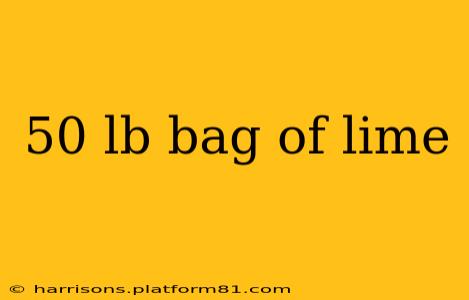Agricultural lime, a crucial component for soil health, is often sold in 50 lb bags. This comprehensive guide dives into everything you need to know about using a 50 lb bag of lime, from selecting the right type to understanding its application and benefits. We'll also tackle some frequently asked questions to ensure you're fully equipped to improve your soil's condition.
What is Agricultural Lime?
Agricultural lime isn't the lime you use in margaritas! It's a naturally occurring material, primarily calcium carbonate (CaCO₃), that's mined and processed to improve soil pH and nutrient availability. It's a crucial amendment for many soils, especially those that are too acidic. Acidic soils can hinder nutrient uptake by plants, leading to poor growth and reduced yields. Applying lime raises the soil pH, creating a more favorable environment for plant roots to thrive.
Types of Lime Available in 50 lb Bags
Several types of lime are available, each with its own characteristics:
-
Calcitic Lime: This is the most common type, derived from limestone. It's a slower-acting source of calcium and raises soil pH effectively.
-
Dolomitic Lime: This type contains both calcium and magnesium carbonates. It's beneficial for soils deficient in magnesium, offering a dual benefit of pH adjustment and magnesium supplementation.
-
Hydrated Lime: This is a quick-acting form of lime, often used in situations requiring immediate pH correction. However, it's generally more expensive than calcitic or dolomitic lime.
The choice of lime depends on your soil's specific needs. A soil test is crucial in determining the type and amount of lime necessary.
How Much Lime Do I Need for a 50 lb Bag?
This is a crucial question with no single answer. The amount of lime needed depends heavily on:
-
Your soil's pH: A soil test reveals your current pH and the recommended amount of lime to reach the optimal range for your plants.
-
Soil type: Different soil types have different buffering capacities, influencing the amount of lime required to achieve the desired pH change.
-
Soil texture: Clay soils typically need more lime than sandy soils.
-
The type of lime used: The effectiveness of different types of lime varies.
It's crucial to conduct a soil test before applying any lime. Your local agricultural extension office or a soil testing laboratory can provide this service. They will give you precise recommendations based on your soil's unique characteristics. Ignoring a soil test and applying lime haphazardly can be counterproductive.
How to Apply Lime from a 50 lb Bag
Once you know the recommended amount, applying lime is relatively straightforward:
-
Spread evenly: Use a spreader to ensure uniform distribution across the area. Uneven application can lead to localized pH variations.
-
Incorporate into the soil: Till the lime into the top few inches of soil for better incorporation and effectiveness.
-
Water thoroughly: After application, water the area well to help the lime dissolve and penetrate the soil.
How Long Does It Take for Lime to Work?
Lime doesn't work instantly. The effects of lime application are typically gradual, taking several months to a year or even longer to fully impact soil pH.
What are the Benefits of Using Lime?
Beyond raising soil pH, lime offers several benefits:
-
Improved nutrient availability: Increased pH improves the uptake of essential nutrients like phosphorus and molybdenum.
-
Enhanced microbial activity: A neutral to slightly alkaline pH supports beneficial soil microbes.
-
Better soil structure: Lime can help improve soil aggregation, resulting in better drainage and aeration.
-
Reduced aluminum toxicity: High aluminum levels in acidic soils can harm plant roots; lime helps mitigate this.
What Happens if I Use Too Much Lime?
Applying excessive lime can be just as detrimental as using too little. Overliming can raise the pH to levels that are harmful to plants, potentially leading to nutrient deficiencies. Therefore, adhering to the recommendations from your soil test is crucial.
Can I Use a 50 lb Bag of Lime on My Lawn?
Yes, but it’s crucial to follow the same principles as outlined above. Conduct a soil test to determine if your lawn needs lime and, if so, how much. Using too much lime on your lawn can damage the grass.
Where Can I Buy a 50 lb Bag of Lime?
50 lb bags of lime are widely available at most garden centers, farm supply stores, and home improvement retailers.
By following the advice in this guide and conducting a thorough soil test, you can effectively use a 50 lb bag of lime to dramatically improve the health and productivity of your soil. Remember, a little planning goes a long way in achieving optimal results.
